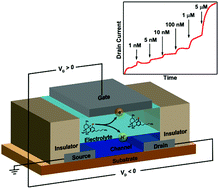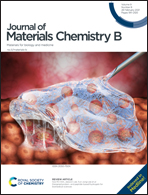Delta-9-tetrahydrocannabinol (Δ9-THC) sensing using an aerosol jet printed organic electrochemical transistor (OECT)†
Abstract
Recreational use of marijuana/cannabis was legalized in Canada in 2018 and has been decriminalized in several other countries; however, the detection of impairment has remained elusive for law enforcement. The psychoactive ingredient in cannabis, delta-9-tetrahydrocannabinol (Δ9-THC), can be detected in saliva and be correlated well with the intake of cannabis. Organic electrochemical transistors (OECTs) have been used for a variety of biosensing applications like glucose, pH, ions, etc. In this work, we demonstrate the use of unfunctionalized OECTs for the detection of Δ9-THC down to 0.1 nM and 1 nM diluted in DI water and synthetic saliva buffer, respectively. These OECTs have been aerosol jet printed entirely with PEDOT:PSS as the channel material. Using a platinum gate coupled with an aerosol jet printed OECT, Δ9-THC concentration can be detected due to its oxidation reaction at the gate. These results were consistent with cyclic voltammetry measurements of Δ9-THC using Pt as the working and counter electrode. Utilizing these OECT based sensors, we have achieved high sensitivity of detection of Δ9-THC in the range from 0.1 nM to 5 μM. These OECT based Δ9-THC sensors demonstrate less than 3% error indicating good repeatability which is averaged over 15 measurements on multiple devices.



 Please wait while we load your content...
Please wait while we load your content...